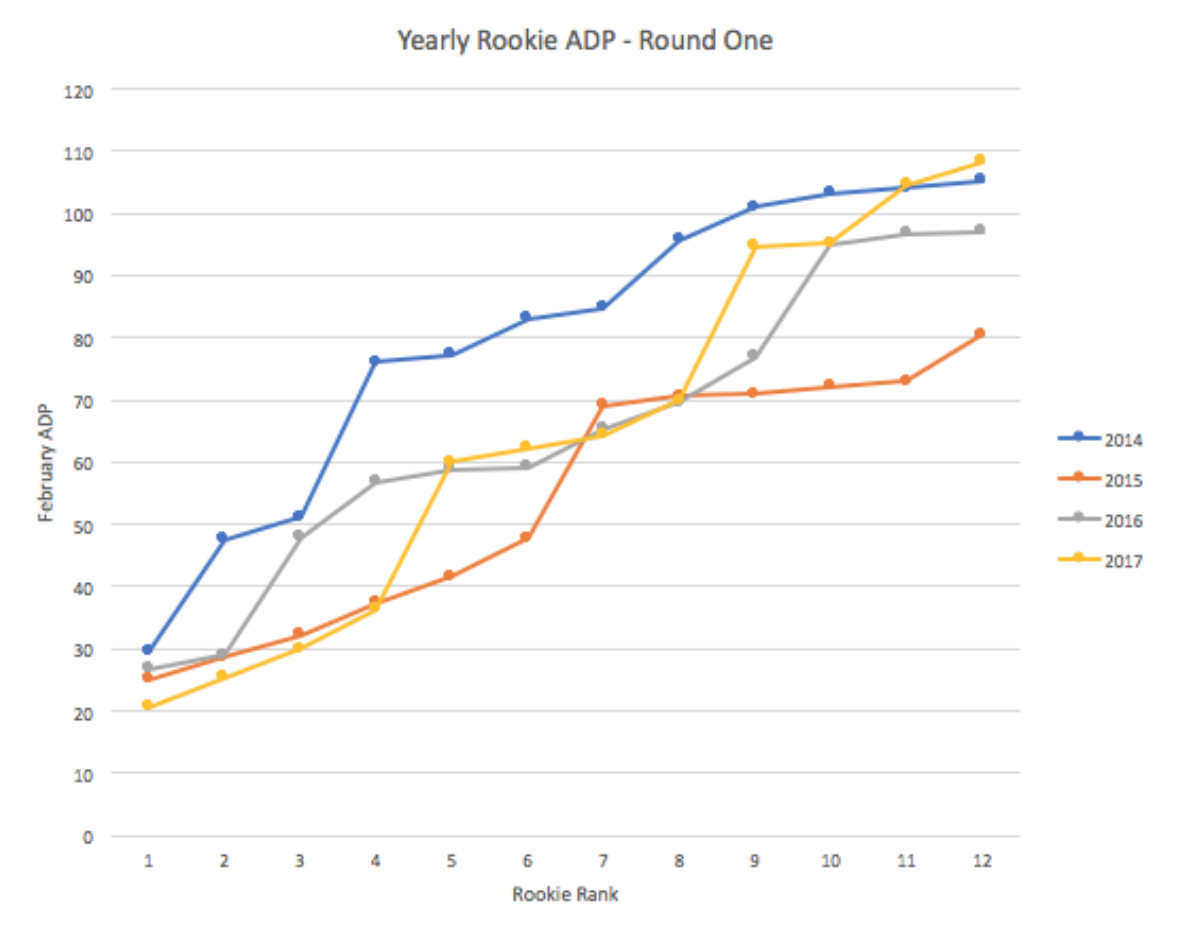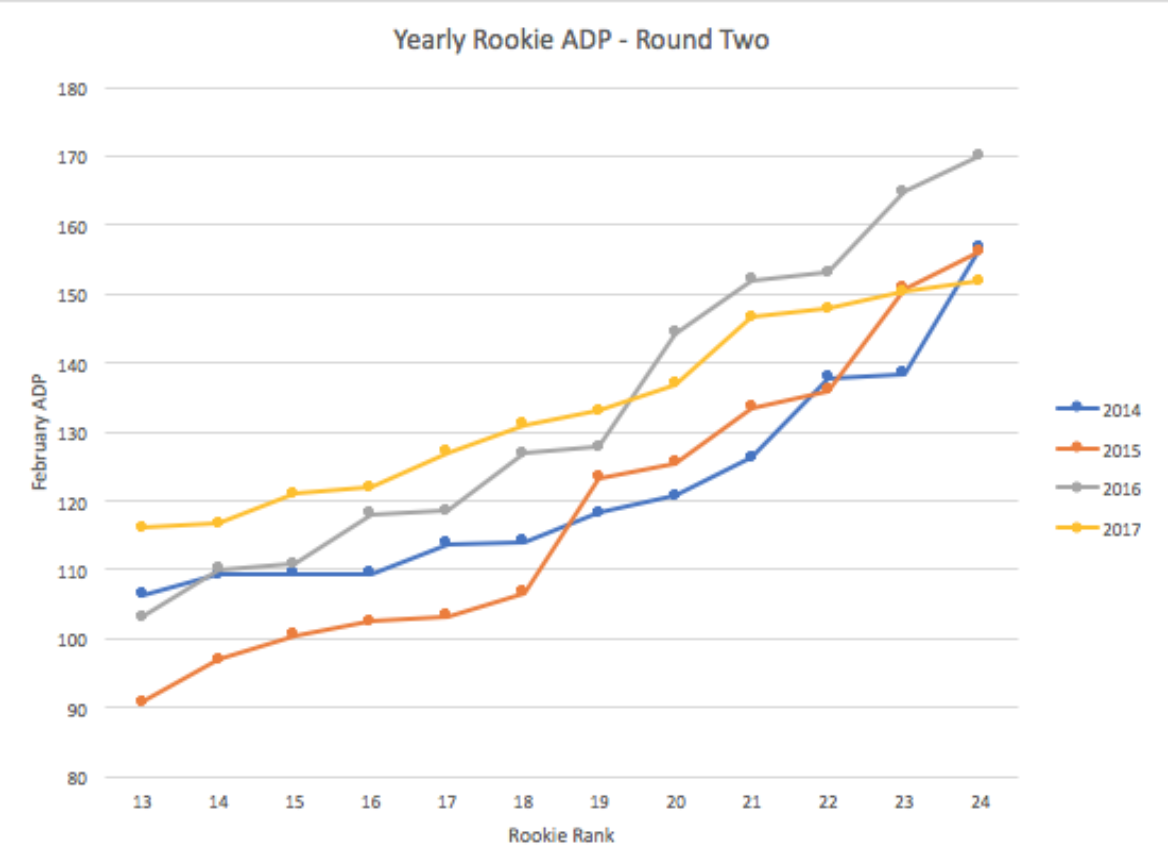Thanks, 2014!
If there was a glossary of terms in a book entitled “Sicknesses of Dynasty Football,” we’d undoubtedly see the following entry:
Rookie Fever: An affliction that artificially causes elevation of the value of rookies, in both startup drafts and the trade market, annually, from the period of February through August. This is a pervasive disease, and there is no known cure.
Okay, is the above a touch overdramatic? Sure. However, the goal here is to once again strike home the point that in the minds of many dynasty owners, rookies are worth their weight in gold.
But what if I told you that it wasn’t always the case? Piling on, what if the root cause of Rookie Fever is because the greatest rookie class in recent memory, the dynasty elite of 2014, was actually undervalued? Let me explain.
Two recent events coalescing have allowed me to perform an analysis on the historical ADP of rookie players. First, MyFantasyLeague.com incorporated the 2017 rookies into the player pool, enabling the gathering of their draft data. Second, the DLF ADP Archives opened their vaults, going all the way back, fortuitously so, to the winter on 2014.
With the publication of the February 2017 ADP now in hand, I was able to compare the draft positions of the past three rookie classes, along with the upcoming freshmen. The data is shown below, as taken from February of the years 2014-2017. It shows the top-24 rookies (as per ADP) for each year.
[am4show have=’g1;’ guest_error=’sub_message’ user_error=’sub_message’ ]
|
2014 |
2015 |
2016 |
2017 |
||||
|
Player |
ADP |
Player |
ADP |
Player |
ADP |
Player |
ADP |
|
29.5 |
25.0 |
26.7 |
Dalvin Cook |
20.7 |
|||
|
47.5 |
28.7 |
29.0 |
Leonard Fournette |
25.3 |
|||
|
51.2 |
32.2 |
47.8 |
Corey Davis |
30.0 |
|||
|
76.0 |
37.3 |
56.8 |
Mike Williams |
36.3 |
|||
|
77.3 |
41.7 |
58.8 |
Joe Mixon |
60.0 |
|||
|
83.0 |
47.7 |
59.2 |
JuJu Smith-Schuster |
62.3 |
|||
|
84.7 |
69.0 |
65.3 |
Christian McCaffrey |
64.3 |
|||
|
95.7 |
70.7 |
69.7 |
John Ross |
70.0 |
|||
|
101.0 |
71.0 |
77.0 |
Samaje Perine |
94.7 |
|||
|
103.2 |
72.2 |
95.0 |
O.J. Howard |
95.2 |
|||
|
104.0 |
73.0 |
96.7 |
Alvin Kamara |
104.5 |
|||
|
105.2 |
80.5 |
97.0 |
D’Onta Foreman |
108.3 |
|||
|
106.3 |
90.8 |
103.2 |
KD Cannon |
116.0 |
|||
|
109.3 |
97.0 |
110.0 |
David Njoku |
116.7 |
|||
|
109.5 |
100.5 |
110.8 |
Carlos Henderson |
121.0 |
|||
|
109.5 |
102.5 |
118.0 |
Kareem Hunt |
122.0 |
|||
|
113.8 |
103.3 |
118.5 |
Evan Engram |
127.0 |
|||
|
114.0 |
106.7 |
126.8 |
Curtis Samuel |
131.0 |
|||
|
118.3 |
123.3 |
127.8 |
Zay Jones |
133.0 |
|||
|
120.7 |
125.5 |
144.3 |
Malachi Dupre |
136.8 |
|||
|
126.3 |
133.5 |
152.0 |
Jamaal Williams |
146.7 |
|||
|
137.8 |
136.0 |
153.2 |
Wayne Gallman |
147.8 |
|||
|
138.5 |
150.8 |
164.8 |
Isaiah Ford |
150.3 |
|||
|
156.8 |
156.2 |
170.0 |
Dede Westbrook |
151.8 |
|||
Now one can argue that using the February data is inconclusive, as the players haven’t yet gone through the NFL Combine or been drafted by their respective teams. I can get behind this to an extent, and will do a subsequent post-draft analysis later. But the fact is that there are dynasty enthusiasts who draft their teams in the early stages of the year. Perhaps more importantly, early-year rookie ADP contains the raw emotions of how we feel about these players, before our opinions become clouded by 40-yard dashes and NFL landing spots.
What can be immediately gleaned is that the 2014 ADP is lower across the board for the “first round” (i.e. top 12) of rookies. Apart from Bills receiver Sammy Watkins, the gaps at each slot are distinct, a fact further highlighted in the chart below.

To briefly explain, this X-Y scatter plot shows four lines, color coded to each year (legend on the right). The X-axis shows the “rank” of each rookie (in agreement of descending order in the table above), and the Y-axis shows the ADP of that player. As an example, the Y-intersect of the “X” value of “5” in the year 2016 (gray line), essentially states that Michael Thomas was the fifth-highest drafted rookie in February of 2016, and his ADP was 58.8.
As shown above, excepting the 11th and 12th ranked rookies of the 2017 class having slightly lower ADPs, the 2014 ADPs are lower at every position across the board, for every year. In other words, in February of 2014, dynasty owners flat out missed the boat on how good that class was going to be.
The second round was more normalized, as shown in the chart below, which is similar to the graph above, but for the next dozen rookies.

Here we see that the 2014 class was actually valued more highly than in both 2016 and 2017, perhaps owing to the quality of depth. Yet for 2015, the 13th through 18th ranked rookies were still, on average, being selected earlier. The 2016 class fell off the pace, likely due to the perceived shortage of talent, and the 2017 class is about a round below across the board.
This is all neatly summarized in the next table, which shows the ADP values of the 2014 class (players 1-24), and how much higher or lower the equivalent ranks were for the next three years.

The green cells signify that the rookies at that draft slot (1-24) were drafted more highly, with the red cells showing the opposite. Noticeably, 2015 was highly divergent, with 20 of 24 draft slots being selected higher, and 13 of 24 having over a round (12 spots) of difference. In fact, eight of the first 12 slots have an ADP difference greater than two full rounds!
Even the 2016 class, which was generally panned as lacking both high-end upside (outside of one or two guys) and depth, exhibited a massive jump in ADP for the first “round.” This trend essentially carried over to 2017 as well. All told, it’s fair to say that Rookie Fever, once viewed as a mild irritant, hit a crescendo with a full-blown outbreak in 2015, and has yet to fully subside.
Ultimately, this begs the question – is this merely a history lesson, or is there any actionable data here? Obviously we can’t go back in time and valuate the 2014 class properly, so what good does this really do for us? To that point, I want you to pose to yourself the below query.
Do you believe the 2017 rookie class will perform similarly to the 2014 rookie class?
The 2017 class has been hyped for some time, with owners believing in both the high-end talent and depth. Well, suppose your belief is that the hype becomes real. I’d urge you to consider the ADP figures for the 2015 class, which reflect a dramatic overcorrection in ADP, as owners kicking themselves for missing the previous year wanted to ensure they procured the next big things.
If the events unfold in a similar manner, you’re going to want to make sure you stockpile as many 2018 rookie picks as possible (I know that the rookie draft and dynasty ADP are two separate entities, but at a minimum there’s a correlation between rookie ADP and how the rookie draft picks will be valued). In fact, it doesn’t even matter what type of owner you are – ageist, moderate, or veteran-centric. Youth-loving dynasty owners will want to get their hands on these picks before they skyrocket in price, so that they can obtain players’ rights at a relatively cheap cost. Risk-averse owners should still want to trade for these picks, as they can sell them later for a greater take, akin to a penny stock blowing up.
If you believe the 2017 class is overrated, and that these players won’t be able to create enough year-one buzz to drive up 2018 costs (akin to the disparate ADPs between 2015 and 2016, or 2016 and 2017), then you can consider the opposite. Look to sell your 2018 picks at some point during the season, seeking out proven players who can help you now and come with less possible hazard. Just remember, however, that this remains an overarching trend, not a player-specific analysis – even if the cost of 2018 picks decreases across the board by virtue of a failing 2017 class, there will obviously still be individual players who will thrive regardless.
No matter what happens in 2017, I’m of the belief that Rookie Fever is here to stay. The 2014 class was too good and too numerous, and the dynasty community wasn’t ready for their contributions. Much like the days of sub-dollar gas prices, this seismic shift may experience micro-evolution on a yearly basis, but the high rates aren’t going anywhere. Thanks, 2014!
Follow me on Twitter @EDH_27
[/am4show]
- Dynasty Fantasy Football Mailbag: Is Kendre Miller Valued Unfairly? - April 17, 2024
- Forgotten Dynasty Veterans: Bottom Tier - April 9, 2024
- Dynasty Fantasy Football Mailbag: How Much Should You Factor in Off-Field Issues? - April 9, 2024


































































